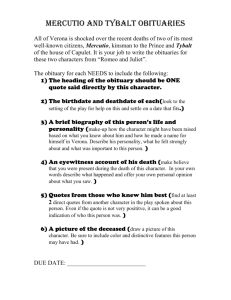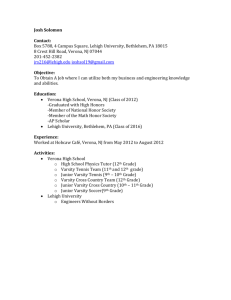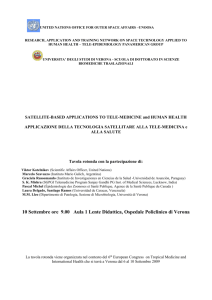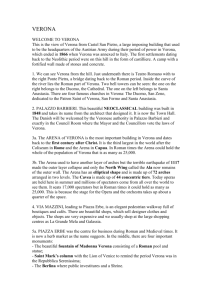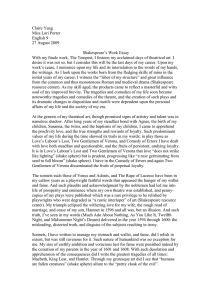roman verona
advertisement
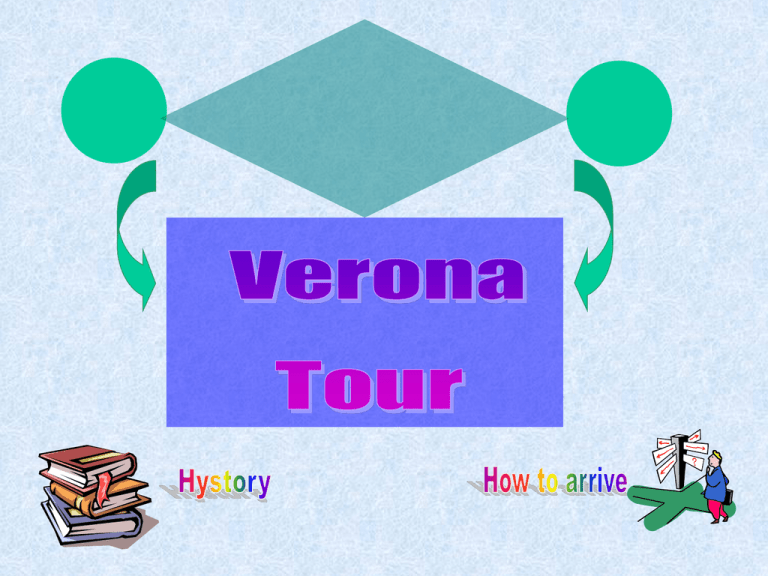
VERONA ditances Trento km. 103 Bolzano km. 157 Vicenza km. 51 Venezia km. 114 Brescia km. 68 Milano km. 161 Bologna km. 142 Firenze km. 230 By plane: The international Catullo airport inVerona Villafranca is about 10 kilometres far from the city centre. To get information on flying schedules, please call this telephone number: +39 045 8095666 (from 6 am till 12 pm). There’s a bus service leaving from and to the airport every 20 minutes from 6.10 am till 11.30 pm (for further informations please call at +39 045 8004129, ticket fee: L. 7.000). The Air Terminal is located in front of Porta Nuova railway station. By car: you can easily get to Verona by highway Serenissima (A4, Milano-Venezia, take the exit to the centre: Verona Sud) or by the highway Brennero/Modena (A22, take the exit to Verona Nord). By train: the main railway station is Verona Porta Nuova, where the two railways Milano-Venezia and Roma/Brennero meet. There are trains leaving from the main railway stations of northern Italy almost every hour (for further information call this number: 147-888088 from 7 - 21). ART AND HISTORY ITINERARIES Any one of the following itineraries offers unique opportunities to walk through th beautiful pages of the history of art, converting the classic Roman, the High Medieval, the city-state or free commune, the Renaissance and the Baroque periods, the eighteenth century and Hapsburg epochs, as well as prestigious examples of modern architecture. Roman Verona Verona as a City State Verona of the Scaligers Venetian Verona Austrian Verona Churches and Monasteries • • ROMAN VERONA We can start from Piazza Bra (from the old German word ´breit´ meaning ´wide´): it lies in the south of the Roman city, outside its town walls, and is dominated by the Arena amphitheatre, the third largest such building built in the time of Flavius (1st Century A.D.): it is a clear sign of the importance of ancient Verona, as it could hold more than 20.000 spectators. Today, it is the Summer home of great lyric opera, applauded by thousand of people. The outer circle, of which just four arches over three storeys remain, collapsed following the earthquakes of 1117 and 1183, whereas the inside seating is the work of an admirable restoration project begun in the XV Century. The Maffei Museum, on the opposite side of the square, in the coutryard of the PhilarmonicTheatre, houses an exhibition of Greek, Roman and Mediaeval epigraphs collected by the Veronese scholar Scipione Maffei in the 1700s. Behind the arena itself, in the small square called "Mura di Gallieno", as also the west in Corte Farina, one can see substantial remains of the Gallieno walls, built in all haste by the Emperor Gallieno. The most ancient walls stood eight metres further north, running to the east along the present-day Via Leoncino down to Porta Leona Gate, of which we can still admire the internal facade and the base of one of the two towers, and to the west as far as the River Adige, with an opening for the Porta Borsari Gate, of which the exterior facade still remains: both gates were built in the time of Flavius (1st Century A.D.): Porta Borsari stood on the Decumano Massimo (decumanus), the major north-south road, identifiable today as Corso Porta Palio, Corso Cavour and Corso Portoni Borsari, while the Porta Leona was the starting point for the administration of the Veronese people for Shakespeare and his universal art has its focal point: Juliet’s House continue Back to Hystory • Walking along these streets, or down Via Mazzini on the north west side of Piazza Bra (one of the very first streets in Italy converted into a pedestrian precinct, and now lined with exclusive shops), we get to Piazza Erbe: the ancient forum, the civic, political and religious heart of the early city which within its walls cover a surface area of around 440.000 sq.m. The colourful fruit and vegetable market has sbeen here for more than two thousand years, alongside the buildings of the late Mediaeval and Renaissance periods, and some of the most beautiful frescoed houses in all Verona (Casa Mazzanti, north side), the ancient Torre dei Lamberti, the still older Gardello tower next to the splendid Maffei Palace, home of the Tourist Board, and the so-called Ghetto. The whole area around the Piazza Erbe, standing 3.5 meters higher than the Roman level, is a wealth of remains of Roman pavement, all easily seen in the nearby courtyards and squares. Crossing the river by the Roman bridge known as Ponte Pietra, one comes to the Roman Theatre: restoration work, begun in the XVIII Century, has brought to light one of the most interesting monuments of the very early Imperial period, built into the Hill of St. Peter's, Verona's most ancient residential area, with an air space up to 20 meters high. Re-crossing the Adige, the western side is occupied by the complex of buildings of the Duomo, Verona's Cathedral, built on an ancient spa site, where a significant number of traces of a paleochristian basilica (IV-V Century A.D.), have been found. Back to Hystory • • VERONA AS A STATE CITY We con start from the Roman monument of the Gavi Arch, today placed in the small square beside the Scaliger Cstle; it originally stood in the middle of the road and served as a main gate to the city walls, major remains of which can be seen in the walls of the castle itself, a jewel of European architeture of the city-state era: the postern of Morbio (XII Century), so called after the owner of the farm-holding which opened out on the banks of the river. To the east, the wall is hidden by the houses in Via Roma, but one can still se the Tower (in Via Manin), rebuilt on the site of an older tower dating from the times of the tyrant Ezzelino (XIII Century) and a previous city tower of the XII Century. Another tower dating from the city-state period is even large, again built by Ezzelino and subsequently rebuilt several times: the Pentagonal tower, to the side of the Bra Gates opening out into the Corso Porta Nuova, which runs on the western side of the Visconti "Citadel". Passing on through the Piazza Bra, the walls rebuilt in the Scaliger period reappear, but there are also important remains of the internal city state walls in Via Adigetto, so called as there once flowed here a natural branch of the River Adige starting south of the Scaliger castle and re-entering the Adige itself at the Straw Tower (Aleardi Bridge). The city -state wall stood a little inside the present-day route of the Stradone Maffei and the Stradone S. Fermo, the latter named after the ancient Benedictine Convent run by the Franciscans: it was a customs/port area which passed thruogh the Via Postumia joining the Cardo Massimo. continue Back to Hystory • The heart of the free commune area of Verona is Piazza Erbe, on the southern side of which stands the Domus Mercatorum (XII Century), and, on the other side, the solid Communal Tower standing alongside the later, more elegant Lamberti Tower; the Piazza Dante, surrounded by the Palace of Justice, the Communal Palace, and the "Palazzo dei Signori"; the Old Market Square, a wonderful example of building style in the free commune era. These are joined and interspersed by streets and alleys • to the river or the Cathedral, narrow and outside the Roman stree plan, fortified with full-scale stronghold houses, such as the one in Via Arche Known as Romeo's House, a complex dings standing between Corso S. Anastasia and Via Emilei, Where the Gallery of Modern and Contemporary Art is Housed. It is the fortess palace of tyrant Ezzelino da Romano. • The other part of the city-state area of Verona lies across the Adige, around the more ancient Cathedral of Verona, the current Church of S. Stefano, up to the Valdonega suburb, a Longobard site. Also dating from the Longobard period are the foundations, in the small valley to the east, of the Church of S. Giovanni in Valle, the Germanic Cathedral of "barbaric"Verona. Back to Hystory THE SCALIGERS VERONA These itineraries are inextricably intertwined with the history of the free commune of Verona as the Scaliger lordship emerged from the city-state. The Scaliger period of Verona is one of great political influence, economic power and territorial expansion. The walls which stand on the first hills to the north bear ample witness to his golden age, as do the numerous Scaliger Castles standing throughout the Province at Malcesine, at Soave, at Montoria and Villafranca, at Torri del Benaco, and Lazise and the imposing remains of the castle at Valeggio. These are joined by all the other castles and towers on Lake Garda (Biaza, Castelnuovo), in the hills (Illasi) and in the southern plains (Isola della Scala, Sanguinetto, etc...). •Yet the real focal point of this period are the public and private buildings of these lords who came to Verona from the east in the XIII Century: the Case Mazzanti, which still bear on their rear side the metal bars and beams used to draw water from the fifteenth century well; the Scaliger Palace, now the Head Offices of the Provincial Council, with the Scaliger Arches, the burial palace of the Scaliger lords decorated by the leading sculptors of the XIV Century, such as Bonino da Campione and Giovanni di Rigino; and the private Scaliger chapel, the Church of S Maria della Scala. continue Back to Hystory • And Castelvecchio itself, the Scaliger stronghold at the south-west of the city, construction of which began in all haste in 1354, when the power of the Scaliger lords was alreadyirremediably in decline. The bridge which crosses the River Adige opens to the north towards Germany, a statment of the fact that the Scaligers were Ghibellines supporting the Emperor. Today, the main, central structure of the castle flanking the river houses the Museum of Ancient and Modern Art, houseng periods, with works by Pisanello, Stefano di Francia, Caroto, Bellini, Paolo Veronese, Tintoretto and many others. Back to Hystory • • • VENETIAN VERONA The main concern of the Venetians was to fortify Verona and besides the fifteenth and sixteenth century palaces, the most important of which is undoubtedly the "Loggia di Fra'Giocondo" in Piazza dei Signori (Dante), the walls and the various military defensive and offensive mechanisms built and installed undoubtedly represent the most significant monuments of this period, many of which are the work of Michele Sanmicheli: these include the huge hilltop bastions, such as the Bastione delle Boccare, near the Church of S. Stefano, one of the most singular and imposing military structures of the XVI Century, and the town gates of Porta Palio, Porta Nuova, Porta Vescovo, and Porta S. Zeno. • The walls into which these gates were built were so thick and deep that they now house gardens and jogging runs (Bastioni di Spagna). Moreover, Venice pratically turned Verona into a siege town with the building of two well-fortified citadels: Castel S. Felice and Castel S. Pietro on the hills to north of the city and in the lower ground with "Cittadella": this work was the continuation of the originalproject of the Visconti Dukes in the twenty year period in which verona was a dominion of Milan at the end of the XIV Century. The Milanese architects had designed the whole city as a compact and massive fortress on its eastern border with rival power, Venice, which, however, took the city in 1404. This period also includes the palaces, such as Sanmicheli's Palazzo Bevilacqua in Corso Cavour and the later Palazzo della Gran Guardia, in Piazza Bra. Back to Hystory • • AUSTRIAN VERONA If one travels to Verona from the south, one cannot but see the forts and strongholds which are scattered on the Veronese hillsides, such as S. Mattia, S. Leonardo (now converted into the Sanctuary of the Madonna of Lourdes), and S. Sofia, linked together by an entrenched military road nicknamed "lasagne", which moves upwards from the Church of S. Giorgio, on the banks of the Adige, to S. Mattia, the highest of these forts which, with the Austrians "Torricelle and the ring of suburban strongholds, compose a tight complex characterised by their massive walls in irregularly hewn tufa. • An Italian engineer, Barbieri, designed the "Palazzo del Comune" under the Austrians: a solid building in the neo-classical style which occupies the entire eastern flank of Piazza Bra. Back to Hystory CHURCHES AND MONASTERIES We have kept these to last as they alone compreise an interesting itinerary. We can start from the Basilica di S. Zeno, standing inside the Scaliger and Venetian Walls, But originally completely outside the town area. The Abbey and Church complex dates from the V and XIII Centuries, and has been repeatedly added to and restored. The Bronze Doors in the main porch with forty-eight Biblical plaques (X-XI Centuries) and the Triptych by Andrea Mantegna are Just two items of exceptional interest. •On the eastern side of the recently-restored, magnificent square stands the Church of S. Procolo, a building which summaries a thousand years of Christianity in Verona from the IV-V to the XIV Centuries. Other important convents and religious sites near S. Zeno include S. Zeno in Oratorio, to the side of Castelvecchio; the Franciscan convent of S. Bernardino and its splendid works of art. continue Back to Hystory • Moving to the other side of the Corso Porta Nuova, there is the Church of SS. Trinita', the remains of the ancient convent of reformed Benedictines. The Benedictine Abbey of S. Fermo has already been mentioned: the lower church is a complete gallery of XI Century fresco art. The oldest Benedictine Convent in Verona, on the right bank of the River Adige, is S. Maria in Organo: the present-day church holds some of Europe's most famouse inlaid choir stalls, the work of Fra Giovanni, a Reinaissance artist praised by Vasari. • These are joined by the complex of basilicas in the Duomo area: S. Maria Matricolare, S. Giovanni in Fonte, and S. Elena. The Basilica of S. Anastasia is a splendid example of Domenican art and for five centuries the "hunchvacks" just inside the door have supported two red marble holy water stoups. Standing on the Roman Decumanus, in the area of the ancient cemetery, are the Sacellum of SS. Teuteria and Tosca (V Century) and of SS Nazaro and Celso - collected today for the greater part in the Fresco Museum at the Tomb of Juliet: fine examples of an art-form which spread out from Verona to the valleys of the Alto-Adige and north to the furthest borders; and the churches of SS. Apostoli and S. Lorenzo, which once again link Veronese art with the rest of Europe at the same time as highlighting connections with Provence and Catalan ideas. The European leaning is also highlighted in the Province. Back to Hystory
